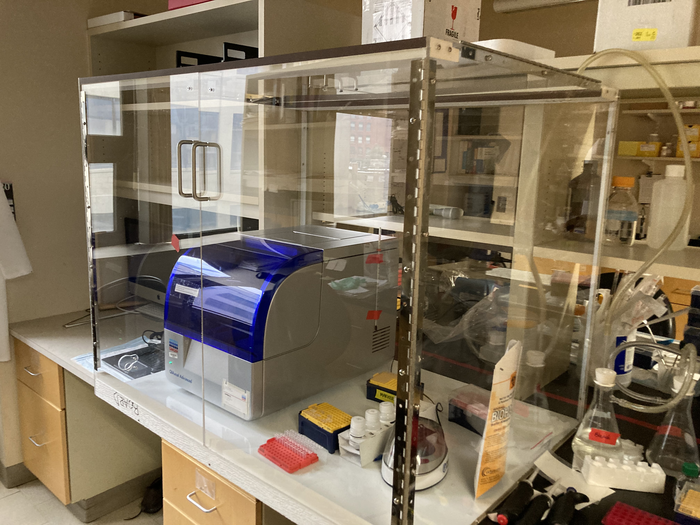Brown University researchers have developed a breath test for COVID-19. The breathalyzer, which they called a bubbler, is a tube that someone blows into for fifteen seconds. The tube contains a mixture of enzymes that reverse transcribe the RNA in viral particles into DNA, which enables a subsequent laboratory PCR test.
 Breathalyzers were immersed in UV light to maintain a sterile field before kits were made for the clinical trial at Rhode Island Hospital. Above: Bubbler kits were processed in a negative pressure benchtop box to prevent contamination of amplicon particles in the laboratory (source: William G. Fairbrother)
Breathalyzers were immersed in UV light to maintain a sterile field before kits were made for the clinical trial at Rhode Island Hospital. Above: Bubbler kits were processed in a negative pressure benchtop box to prevent contamination of amplicon particles in the laboratory (source: William G. Fairbrother)
The technology is primarily a different way to collect COVID-19 test samples, however, as it measures the virus in exhaled air. it can be more informative than nasal swabs to indicate whether someone is actively transmitting the virus.
At this point, many of us had a nasal swab test for COVID-19. Inserting the swab is uncomfortable, so a non-invasive breath test would likely be more comfortable. However, measuring virus particles in the air we breathe can also be more meaningful, as airborne transmission is one of the most important ways of spreading COVID-19.
In addition, detecting the virus in nasal swabs can be misleading, as people in this region can sometimes test positive for the virus even though they are not infectious, and sometimes it can take months. In such circumstances, the swab test is more likely to pick up traces of the virus than active virus particles. Breath tests can also provide more information about lower respiratory tract involvement, which is a risk factor for some of the more dangerous COVID-19 symptoms like pneumonia.
“Lower respiratory involvement is often a precursor to severe COVID-19, so there is an argument for more direct sampling that focuses on exhaled air,” said William G. Fairbrother, a researcher involved in the study.
So far, the Brown team tested the bubbler on 70 patients at Rhode Island Hospital and found it could be used to successfully detect the virus, and the results are more predictive of lower airway involvement than nasal swabs. The breath samples contained higher amounts of viral RNA than swab samples from the same patients. Another use of the technology can be to act as a “COVID alert” that can test the air in enclosed spaces and issue a warning if virus particles are detected.
“Such technologies could be useful in restoring service to industries like hotels, cruise lines and casinos,” said Fairbrother. “In addition, routine air tests at early warning locations such as traffic hubs and hospital emergency rooms have an epidemiological benefit.”
Study in the Journal of Molecular Diagnostics: Efficient detection of the severe acute respiratory syndrome coronavirus 2 (SARS-CoV-2) from exhaled air
Over: Elsevier
